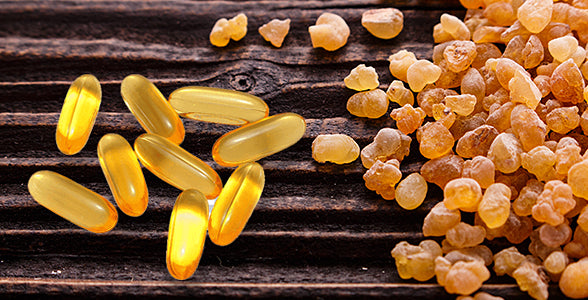
INGREDIENT SCIENCE: Frankincense and Fish Oil: From Wealth to Gut Health September 17, 2019
Share
When it comes to incense or essential oils, frankincense is an esteemed veteran, dating back to ancient times. It was heralded by Pliny the Elder for making the “southern Arabians the richest people on earth,”[1] used by ancient Egyptian women and the likes of Cleopatra as their eyeliner of choice and most famously one of three gifts offered by the three wise men to baby Jesus as a sign of divinity. While historically known for its connection to wealth, beauty and biblical status, frankincense is also a game-changer when it comes to health.
Commonly used for its medicinal properties, Indian frankincense (Boswellia serrata) is a tree native to India and Arabia, whose resin has proven to provide support for many kinds of health challenges.
More recently, research has highlighted frankincense’s role in digestive support, attributed to Boswellia Phytosome®, a clinically-studied ingredient that soothes the lining of the intestines to reduce digestive irritation and discomfort.*[2] Here’s everything you need to know about the amazing health benefits of Indian frankincense, including how it can be used as a key component in aiding digestion.
In addition to helping soothe the gut lining, frankincense also speeds up the secretion of digestive enzymes, assisting digestive system detox. For those with irritated digestive systems, frankincense can be essential to producing regular bowel movements, relieving discomfort, flushing out excess water and reducing occasional cramping and bloating.
A Promising Study
In a recent clinical study, 71 participants who suffered from irritated digestive systems were split into two groups: one a control group, and the other a group that took supplements of Casperome — the Indena Phytosome formulation of Boswellia serrata — once a day for four weeks. The study found that the Casperome-supplemented group experienced a significant decrease in their symptoms (abdominal pain, altered bowel movements, meteorism and cramps) — from 58% down to only 12.5%.[3] This suggests Boswellia serrata (or more specifically, Casperome) may offer a promising alternative for these individuals.
How to Incorporate Frankincense Into Your Health Routine
We have learned that supporting your microbiome is key to your digestive and overall health. So, how can we take frankincense to most effectively aid us internally and improve digestive function? Our Aqua Biome™ Fish Oil +Digestive Relief offers the perfect solution by including Indian Frankincense Phytosome as an essential ingredient in our fish oil capsules to help your microbiome flourish. Combined with a carefully researched ratio of omega-3s, which have shown to be crucial to gut health (proper ratio in supplementation is more important than high dosages alone), our supplements provide total digestive support and encourage a healthy, diverse microbiome. The active ingredient Boswellia Phytosome® added to our fish oil capsules has been proven to soothe the lining of the intestine, reducing both digestive irritation and discomfort.* They also support normal intestinal motility, providing relief from gastrointestinal upset as well as digestive issues stemming from irritated digestive systems.
If you are interested in finding out more and would like to add Indian Frankincense Phytosome to your diet to help with digestive health, visit our supplement page here: https://enzymedica.com/collections/microbiome-support/products/aquabiome-fish-oil-digestive-relief

[1] https://www.jstor.org/stable/228769?seq=1#page_scan_tab_contents
[2] https://books.google.com/books?id=OOeYaMlcZYEC&pg=PA48&dq=Pliny+described+it+as+making+the+%E2%80%98southern+Arabians+the+richest+people+on+earth
[3] https://www.aarp.org/health/conditions-treatments/info-2014/common-digestive-disorders.html
[4] http://www.indena.com/news/irritable-bowel-syndrome-boswellia-as-a-promising-alternative-approach-to-manage-symptoms/
[5] Belcaro G. et al. Eur Rev Med Pharmacol Sci 21(9), 2249-54. 5 2017
[6] https://www.ncbi.nlm.nih.gov/pmc/articles/PMC4928727/

